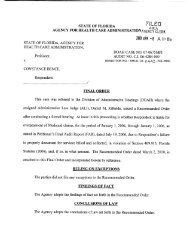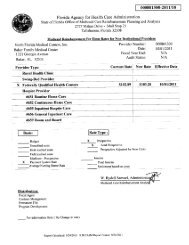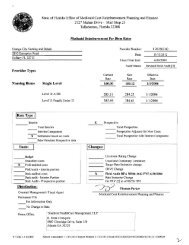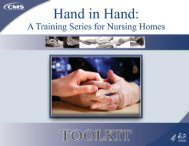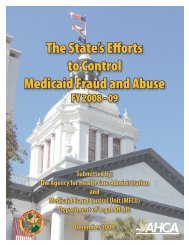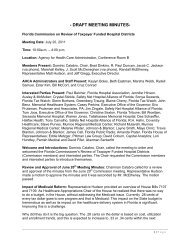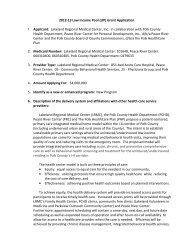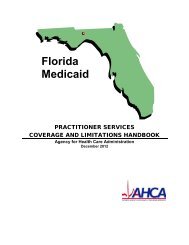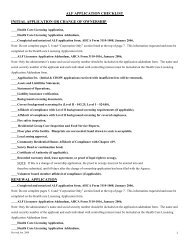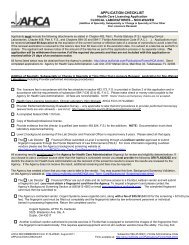Appendix 3D
Appendix 3D
Appendix 3D
You also want an ePaper? Increase the reach of your titles
YUMPU automatically turns print PDFs into web optimized ePapers that Google loves.
November 18, 2008<br />
<strong>3D</strong>-1<br />
APPENDIX <strong>3D</strong><br />
GUIDELINES FOR THE DEVELOPMENT OF JOINT WRITTEN AGREEMENTS BETWEEN<br />
HISTOCOMPATIBILITY LABORATORIES AND TRANSPLANT PROGRAMS<br />
Histocompatibility testing provides clinicians with data to evaluate the immunological risk of proceeding to<br />
transplant. The timing and number of tests may vary depending upon specific needs of the program, waiting times,<br />
sensitizing events in individual patients or other considerations. These should be established to best suit the needs<br />
and concerns of each transplant program drawing upon the expertise of the histocompatibility laboratory. These<br />
guidelines summarize the recommended elements to be included in the joint agreements and provide background<br />
and discussion to support the recommendations. Data cited in reviews of histocompatibility testing for renal (1) and<br />
thoracic (2) transplantation formed the basis for these recommendations.<br />
The following elements should be included in agreements developed between histocompatibility laboratories and<br />
transplant programs:<br />
• A process to obtain accurate and timely history of allosensitization for each patient<br />
• Selection of assay format for antibody screening and for crossmatching<br />
• Selection of timing for periodic sample collection<br />
• Selection of timing for performing antibody screening<br />
• Criteria and a process for establishing a risk category for each patient and crossmatching strategy for<br />
each category<br />
• Criteria and a process for use of Unacceptable Antigens or Acceptable Antigens for organ allocation<br />
• Process for monitoring post-transplant or for monitoring desensitization protocols<br />
• Process for ABO verification compliant with Policy 3.1.4 if laboratory is asked to list candidates for<br />
its transplant center<br />
NOTE: The modification to <strong>Appendix</strong> <strong>3D</strong> (Guidelines for the Development of Joint Written Agreements between<br />
Histocompatibility Laboratories and Transplant Programs) shall be implemented pending notice.<br />
(Approved at the November 2008 Board of Directors Meeting)<br />
History of Allosensitization<br />
It is important to recognize 2 major sources of sensitization:<br />
1. Graft failure – nearly all patients who survive graft failure produce anti-HLA antibodies against<br />
mismatched HLA antigens on the failed graft.<br />
2. Previous pregnancies – up to 25% of women who have had children produce antibodies against<br />
mismatched paternal HLA antigens. This appears to increase with the number of live births.<br />
Either of these factors raises the strong possibility that a patient has been immunized. Other factors may stimulate<br />
antibody production as well (particularly among patients with prior graft failure or pregnancy) including blood<br />
transfusions, vaccinations, certain infections and surgeries. Patients with autoimmune diseases (SLE, Age<br />
nephropathy) may have autoantibodies that will complicate evaluation as these produce false positive reactions in<br />
certain tests. Patients who have any of these risk factors are at high risk of rapidly developing an antibody response<br />
on exposure to alloantigens, so it is also important to determine whether any potential sensitizing events have<br />
occurred since the patient’s antibody status was last tested. Table 1 provides more detail of data to be evaluated in<br />
determining sensitization history.<br />
Detection of Alloantibody: Creating an Alloantibody History<br />
Current technologies for antibody measurement offer sophisticated means to detect circulating antibodies, which<br />
when evaluated in the context of the patient’s sensitization history should provide an estimate of a patient’s risk of<br />
producing antibody on re-exposure to the specific allogeneic HLA antigens of the donor at the time of transplant.
The major technologies are listed in Table 2. These tests (and others) can be used to assess sensitization in transplant<br />
candidates. The strategies should include:<br />
1. Identification of patients who do or do not have circulating alloantibodies to HLA class I and class II<br />
antigens.<br />
a. Initial serial screening should include cytotoxicity and more sensitive tests to identify patients<br />
with antibodies.<br />
b. Several sera should be evaluated to establish a baseline.<br />
2. Characterization of antibody specificity in patients with detectable circulating antibodies using some<br />
combination of:<br />
a. A panel of representative cells for cytotoxicity<br />
b. ELISA tests for specificity<br />
c. Antigen-coated microparticles<br />
3. Monitoring patients who do not have antibodies for their development.<br />
a. Periodic screening of unsensitized patients is important to detect appearance of anti-HLA<br />
antibodies.<br />
b. Characterization of antibody specificity.<br />
The challenge in assessing sensitization status is in evaluating the risk of new patients, previously sensitized patients<br />
and patients with low levels of antibodies that are detected only by more sensitive tests (enhanced cytotoxicity tests<br />
using anti-human globulin (AHG) or flow cytometry) rather than lymphocytotoxicity. Estimating the risk for<br />
patients who have evidence of anti-HLA antibodies that are not detected by cytotoxicity must be accomplished by<br />
considering the patient’s sensitization history. Antibody titers rise after alloantigen exposure and fall over time when<br />
the antigen stimulus is removed, often leaving memory B-cells capable of rapidly expanding and secreting<br />
antibodies. The danger is that even the most potent immunosuppressive agents are not effective against a memory<br />
response which can increase anti-HLA antibody levels within days after re-exposure to HLA antigens on the graft.<br />
Although these antibodies rarely cause hyperacute rejection, they carry a high risk for accelerated acute rejections.<br />
Because patients are first encountered and evaluated at different stages of their overall immunological experience,<br />
the absence of detectable antibodies does not necessarily mean absence of sensitization. Although obtaining a<br />
detailed history of sensitizing events is often difficult, particularly for patients who are geographically distant,<br />
clinical transplant programs and histocompatibility laboratories should work together to optimize obtaining this<br />
information on a timely basis<br />
Periodic Sample Collection<br />
Monthly serum samples for waiting patients should be collected and maintained by the histocompatibility laboratory<br />
to develop an alloantibody history and to facilitate final crossmatches.<br />
Crossmatching Strategies<br />
During the mid-1960’s, Terasaki (3) and Kissmeyer-Nielsen (4) independently discovered that preformed anti-donor<br />
lymphocytotoxic antibodies caused hyperacute rejection of kidney allografts. Patel and Terasaki reported that 24<br />
(80%) of 30 patients transplanted with a positive crossmatch experienced hyperacute rejection and another 3 lost<br />
their grafts within 3 months. Since then a prospective crossmatch has been performed before every kidney transplant<br />
with few exceptions and, as a result, hyperacute rejections are rare.<br />
The crossmatch test is a direct test for antibodies against the HLA antigens of a specific donor. Obviously a patient<br />
with no history of testing for anti-HLA antibodies cannot be considered to be unsensitized. A patient with broadly<br />
reacting circulating lymphocytotoxic antibodies would pose an extremely high risk for a positive crossmatch with a<br />
prospective donor. On the other hand, a patient who, after repeated tests against panels of potential donor cells or<br />
HLA antigen-coated microparticles or other solid supports, has no detectable circulating anti-HLA antibodies is<br />
unlikely to have a positive crossmatch test, assuming that testing was performed against a comprehensive panel of<br />
HLA antigens and there have been no intervening allosensitizing events. In the Patel and Terasaki study, only 4<br />
hyperacute rejections occurred among 168 patients who tested negative against a panel of potential donor cells using<br />
November 18, 2008<br />
<strong>3D</strong>-2
a relatively insensitive test. The specific strategies for evaluating the relative risk of an antibody-mediated rejection<br />
must be developed through a joint collaboration between the histocompatibility laboratory and transplant program.<br />
In thoracic transplantation, prospective crossmatches are not commonly utilized for patients with no detectable HLA<br />
antibodies. In renal transplantation, there may be exceptional cases when it would be advantageous to proceed with<br />
transplantation before a pre-transplant crossmatch can be completed. However, such cases must be approached with<br />
caution to avoid the consequences of unrecognized antibodies (and the underlying immunity they represent) directed<br />
against the donor’s HLA antigens. In all cases where a pre-transplant crossmatch is waived, a peri-transplant or<br />
retrospective crossmatch is recommended to guide post-transplant management. Table 3 lists elements to be<br />
included in crossmatching strategies.<br />
References<br />
1. Gebel HM, Bray RA, Nickerson P. Pre-transplant assessment of donor-reactive, HLA-specific antibodies in<br />
renal transplantation: contraindication vs. risk. Am J Transplant. 2003 Dec;3(12):1488-500.<br />
2. Reinsmoen N, Zeevi A, Nelson K. Anti-HLA antibody analysis and crossmatching in heart and lung<br />
transplantation. Transplant Immunol, 2004 (in press).<br />
3. Patel R, Terasaki PI. Significance of the positive crossmatch test in kidney transplantation. N Engl J Med<br />
1969; 280:735-739.<br />
4. Bergentz SE, Olander R, Kissmeyer-Nielsen F, Olsen TS, Hood B. Hyperacute rejection of a kidney allograft.<br />
Scand J Urol Nephrol. 1970;4(2):143-8.<br />
November 18, 2008<br />
Table 1. Documenting allosensitization<br />
Event Data Notes<br />
Previous graft Date of transplant, organ(s)<br />
Date of graft loss Dates of graft removal, retransplant,<br />
(includes all solid<br />
return to dialysis<br />
organs and bone Cause of graft loss<br />
or tendon<br />
allografts)<br />
HLA typing of donor(s)<br />
Rejection history, history of delayed<br />
function, history of non-compliance or<br />
reduced immunosuppression due to<br />
infection<br />
To aid in interpreting relevance of<br />
alloantibody and to identify potential<br />
Unacceptable Antigens<br />
Pregnancy Number, years of occurrence Gravida and para<br />
Transfusions Number, type of product, month and year<br />
of occurrence<br />
Assist device Type of device, date of placement, Primarily for thoracic transplantation<br />
placement duration of treatment<br />
Disease Identification of disease(s) causing end- Autoimmunity may invalidate some<br />
stage organ failure<br />
laboratory assays<br />
Acute infections Viral infection or bacterial infection Most important if occurred since last<br />
requiring antibiotics<br />
antibody screening test. Induction of<br />
cells or antibodies with specificity for<br />
HLA, non-specific activation of memory<br />
Chronic Viral infection e.g. HCV May effect response to tolerance<br />
infections<br />
induction protocols<br />
Vaccinations Type, date of occurrence Most important for time period since last<br />
antibody screening test.<br />
<strong>3D</strong>-3
November 18, 2008<br />
Table 2. Assays to identify alloantibody (antibody screening or crossmatching)<br />
Assay Description and Use<br />
Standard complement-dependent<br />
lymphocytotoxicity (CDC)<br />
to detect IgG antibodies known to cause hyperacute<br />
rejection<br />
for panel measurements or crossmatch<br />
Anti-human Globulin - enhanced cytotoxicity to improve detection of weak or low level antibodies<br />
(AHG-CDC)<br />
for panel measurements or crossmatch<br />
ELISA-based assays to provide a more sensitive test that does not depend on<br />
complement fixation<br />
Mixed antigens for monitoring<br />
Cell equivalents to measure specificity<br />
Single antigens to measure specificity<br />
Solubilized cells for crossmatch<br />
Flow cytometry-based assays the most sensitive test for antibody<br />
Cell-based for crossmatch or panel measurements<br />
Microparticle-based soluble for panel measurements without background from cell<br />
antigens<br />
membranes<br />
Microparticle-based single for high resolution antibody identification<br />
HLA-antigen beads<br />
Determine isotype of antibody for panel measurements or crossmatches<br />
IgG or IgM<br />
Complement-fixing IgG?<br />
Rule out contribution by autoantibody for panel measurements or crossmatches<br />
Treatment of serum<br />
Autologous cells<br />
Table 3. Recommended elements for crossmatching strategies. Strategies should be tailored to level of risk.<br />
Element Options<br />
Selection of technique(s) See Table 2. Level of sensitivity<br />
Selection of serum Stability of a patient’s antibody response incorporated into choice of<br />
time interval between serum collection and transplant.<br />
Use of historic serum.<br />
Timing Prior to transplant (number of hours or days)<br />
Peri-transplant or retrospective (number of hours or days)<br />
Timed to limit cold ischemia<br />
<strong>3D</strong>-4



